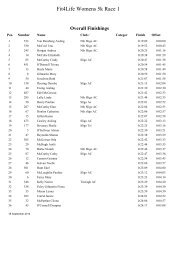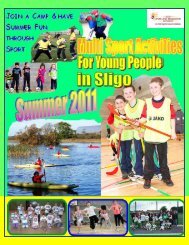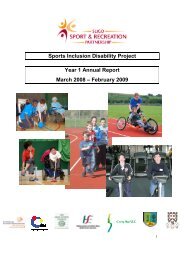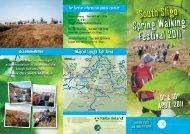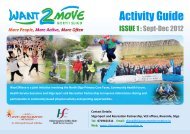Girls Active Programme - Sligo Sport and Recreation Partnership
Girls Active Programme - Sligo Sport and Recreation Partnership
Girls Active Programme - Sligo Sport and Recreation Partnership
Create successful ePaper yourself
Turn your PDF publications into a flip-book with our unique Google optimized e-Paper software.
Executive<br />
Summary<br />
<strong>Girls</strong> <strong>Active</strong> is a physical activity programme targeting<br />
teenage girls in schools in the northwest region of<br />
Irel<strong>and</strong>. It is a joint initiative between the Health<br />
Service Executive West, <strong>Sligo</strong> <strong>Sport</strong> <strong>and</strong> <strong>Recreation</strong><br />
<strong>Partnership</strong>, Donegal <strong>Sport</strong>s <strong>Partnership</strong> <strong>and</strong> Youth<br />
<strong>Sport</strong> West. The programme is designed to increase<br />
the number of teenage girls involved in long-term<br />
regular physical activity through developing more<br />
supportive environments in schools. During the<br />
first two phases of the programme, 2003/4 <strong>and</strong><br />
2004/5, a total of 19 schools participated with 239<br />
girls taking part in the initial year <strong>and</strong> 330 in the<br />
following year. Characteristics of the programme<br />
include consulting with participating girls, providing<br />
non-traditional <strong>and</strong> non-competitive activities such<br />
as Tai Chi or dancing on an extra-curricular basis,<br />
utilising instructors external to the school <strong>and</strong><br />
explicitly linking <strong>Girls</strong> <strong>Active</strong> to the Social, Personal<br />
<strong>and</strong> Health Education <strong>Programme</strong>.<br />
This report presents an evaluation of the first two<br />
years of the programme based on a questionnaire<br />
survey of participating girls <strong>and</strong> on in depth<br />
case studies of three participating schools. Sixty<br />
percent of participating girls from 18 out of the<br />
19 schools taking part in the second phase of<br />
the programme responded to the questionnaire.<br />
For the case studies, one-on-one interviews<br />
were conducted with the principal <strong>and</strong> the <strong>Girls</strong><br />
<strong>Active</strong> co-ordinator in each of the three schools.<br />
In addition, focus group discussions were carried<br />
out in each school with a group of girls who had<br />
participated during 2004/5.<br />
The findings indicate that the <strong>Girls</strong> <strong>Active</strong><br />
programme has increased the number of girls<br />
taking part in physical activity. It has achieved this<br />
by targeting the programme at non-sporty girls who<br />
otherwise take part in little physical activity <strong>and</strong><br />
also by encouraging participating girls to increase<br />
their activity levels outside of the programme<br />
itself. The evidence presented suggests that <strong>Girls</strong><br />
<strong>Active</strong> has raised the total physical activity levels<br />
of participants, especially those who were initially<br />
least active, <strong>and</strong> has increased participation rates<br />
in school PE.<br />
Most of those who took part in the programme were<br />
in senior cycle although this varied a lot across<br />
schools. The girls enjoyed the physical activities<br />
undertaken <strong>and</strong> especially valued the health <strong>and</strong><br />
fun aspects of being involved. They identified the<br />
main barriers to further participation as a lack of<br />
time <strong>and</strong> of available facilities. In general, they<br />
expressed a high level of satisfaction with the<br />
operation of the programme especially in relation<br />
to the organisation of the sessions, the involvement<br />
of the school co-ordinators <strong>and</strong> the quality of the<br />
tutors. While the vast majority of girls had a say in<br />
choosing the activities for <strong>Girls</strong> <strong>Active</strong>, a minority<br />
contributed to organising the sessions due to the<br />
logistics involved.<br />
Not all participants had a timetabled SPHE class<br />
running parallel with <strong>Girls</strong> <strong>Active</strong>, but of those who<br />
did two-thirds discussed physical activity during<br />
the course of the class. There was also some<br />
evidence that school personnel are aware of the<br />
links between <strong>Girls</strong> <strong>Active</strong> <strong>and</strong> other programmes<br />
such as the Healthy Schools Project.<br />
Some problems arose with regard to the difficulty<br />
of scheduling the <strong>Girls</strong> <strong>Active</strong> session at a suitable<br />
time. Lunch appears to be the best time but can<br />
restrict the length of time available for activity<br />
sessions.<br />
It is recommended that the <strong>Girls</strong> <strong>Active</strong> programme<br />
be incorporated into the development of school<br />
policies that are inclusive of participation in physical<br />
activities by all students.<br />
Evaluation of the <strong>Girls</strong> <strong>Active</strong> <strong>Programme</strong> - 2003 – 2005 Report 1



